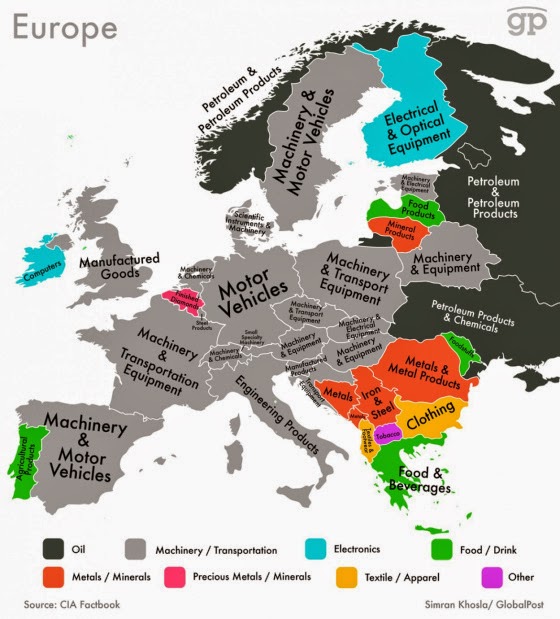Graph(s) of the week: What is specialization?
According to the classical international trade theories of Adam Smith and David Ricardo countries specialize in producing those goods and services in which they have a comparative advantage. Comparative advantage simply means that some countries can produce certain goods more efficiently (at a lower cost) than others. Be it geography, climate, or the presence of certain key resources (land, raw materials, oil, quality labor, capital), each of these may carry a potential advantage making one country relatively better than other countries at producing a particular good.
Relative is the key word here as comparative advantage doesn't imply absolute advantage. Some countries can probably produce all goods better than other countries, but this doesn't mean they have to. They can specialize in what they do best (with respect to all other countries) and leave the production of things they are relatively less good at to other countries and import it from them at a lower cost.
Countries such as the US, Germany or Japan can probably produce any good in the world. But is it better for the US to allocate its resources into e.g. production of clothes and shoes instead of allocating their resources more efficiently into production of computers? They can specialize in producing computers (in which they are, by assumption, the best in the world at), and import clothes and shoes from Mexico, which specializes in precisely these types of goods (see map below). Of course this doesn't imply that the US should have no textile manufacturers nor that Mexico shouldn't produce computers (after all in a globalized world everything is being produced everywhere), it's just a question of opportunity cost of allocating resources into less productive areas vs the more productive ones.
Anyway the theories of comparative advantage and specialization are the central explanations as to why countries trade and why trade is always good and beneficial for everyone involved. Especially the consumers (both parts of the trade equation: exports AND imports).
With this in mind Time magazine brings a few maps showing the main exports (by group of products) of each world economy, which paint a very interesting picture of the different types of goods countries specialize in. Bear in mind the map shows the group of products that bring in the most money to a particular country (so it's not the only good they produce, but the most profitable one). We can easily say that this is the type of good that each of these countries "specialize" in.
Compare Africa to Europe. Africans only export unrefined raw materials or unprocessed food. Europe and America use these goods and build them into actual stuff (and actual food). What is also interesting about Africa is the extent to how rich in resources this continent is. Of all the oil exporters out there it seems that only in African countries the population receives absolutely no benefit from it. Not to mention the gold and diamond exporters. Based on resources alone, Africa should have been very rich by now. Or is it precisely because of such relative wealth in resources that makes them stuck in a low-development trap? The so-called natural resource curse.
These maps give us a very good insight into the level of development each economy is in. Richer countries produce and export heavy machinery and electronics (capital goods), while poorer countries produce and export raw materials, metals, minerals or food (with obviously a few outliers). And there's also a special category: oil. Oil producers are both rich and poor countries. The difference here is simply institutional: how are the countries' elites (owners over the key export resource - politicians in some countries, entrepreneurs in others) using the money from these vast exports of oil: do they grab the profits for themselves by nationalizing the oil industry (Libya, Venezuela, Russia, etc.) or are the oil revenues shared with the majority of the population in ensuring higher living standards and better quality of life (Norway, Qatar, Emirates, Kuwait etc.)?
In conclusion, I feel that the export specialization story may offer a good proxy (or a good instrumental variable) for defining whether a country is rich or poor.
In conclusion, I feel that the export specialization story may offer a good proxy (or a good instrumental variable) for defining whether a country is rich or poor.










And Central America?
ReplyDelete